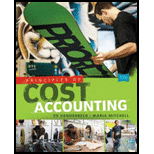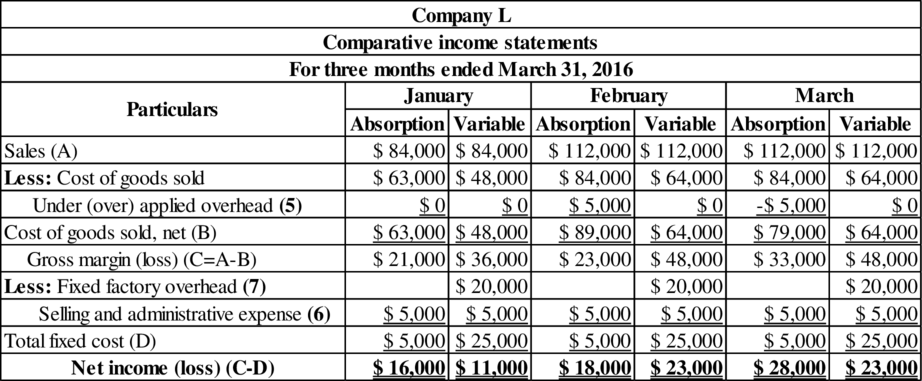
Concept explainers
Prepare comparative income statement and comparative schedule of cost of goods sold for each month under (1) absorption costing method and (2) variable costing method.
Explanation of Solution
Absorption costing: It refers to the method of product costing in which the price of the product is calculated considering all fixed as well as the variable or direct costs. The
Variable costing: It refers to the method of product costing in which the price of the product is calculated considering only the variable or direct costs or the cost that happened to occurred due to the product only. It also called as marginal costing as it takes marginal costs while calculating the product cost.
Prepare comparative income statement and comparative schedule of cost of goods sold for each month under (1) absorption costing method and (2) variable costing method as follows:
Comparative schedule of cost of goods sold for each month:

Table (1)
Comparative income statement for each month:

Table (2)
Working note (1):
Calculate the absorption costing per unit.
Working note (2):
Calculate the ending inventory units for each month.
| Particulars | January | February | March |
| Beginning inventory | 0 | 1,000 | 0 |
| Add: Number of units produced | 4,000 | 3,000 | 5,000 |
| Less: Number of units sold | 3,000 | 4,000 | 4,000 |
| Ending inventory | 1,000 | 0 | 1,000 |
Table (3)
Working note (3):
Calculate the cost of goods sold and ending inventory under absorption costing for each month.
| Particulars | January | February | March |
| Number of units produced (A) | 4,000 | 3,000 | 5,000 |
| Absorption cost per unit (B) (1) | $ 21 | $ 21 | $ 21 |
| Cost of goods manufactured | $ 84,000 | $ 63,000 | $ 105,000 |
| Ending inventories units (C) (2) | 1,000 | 0 | 1,000 |
| Absorption cost per unit (D) | $ 21 | $ 21 | $ 21 |
| Ending inventory | $ 21,000 | $ 0 | $ 21,000 |
| Beginning inventory units (E) (2) | 0 | 1,000 | 0 |
| Absorption cost per unit (F) | $ 21 | $ 21 | $ 21 |
| Beginning inventory | $ 0 | $ 21,000 | $ 0 |
Table (4)
Working note (4):
Calculate the cost of goods sold and ending inventory under variable costing for each month.
| Particulars | January | February | March |
| Number of units produced (A) | 4,000 | 3,000 | 5,000 |
| Variable cost per unit (B) | $ 16 | $ 16 | $ 16 |
| Cost of goods manufactured | $ 64,000 | $ 48,000 | $ 80,000 |
| Ending inventories units (C) (2) | 1,000 | 0 | 1,000 |
| Variable cost per unit (D) | $ 16 | $ 16 | $ 16 |
| Ending inventory | $ 16,000 | $ 0 | $ 16,000 |
| Beginning inventory units (E) (2) | 0 | 1,000 | 0 |
| Variable cost per unit (F) | $ 16 | $ 16 | $ 16 |
| Beginning inventory | $ 0 | $ 16,000 | $ 0 |
Table (5)
Working note (5):
Calculate the under or over applied fixed
January:
February:
March:
Working note (6):
Calculate the fixed selling and administrative expense per month.
Working note (7):
Calculate the fixed factory overhead per month.
Want to see more full solutions like this?
Chapter 10 Solutions
PRINCIPLES OF COST ACCOUNTING
- I am looking for the correct answer to this general accounting question with appropriate explanations.arrow_forwardCan you help me find the accurate solution to this financial accounting problem using valid principles?arrow_forwardI need help solving this general accounting question with the proper methodology.arrow_forward
 Principles of Cost AccountingAccountingISBN:9781305087408Author:Edward J. Vanderbeck, Maria R. MitchellPublisher:Cengage LearningPrinciples of Accounting Volume 2AccountingISBN:9781947172609Author:OpenStaxPublisher:OpenStax College
Principles of Cost AccountingAccountingISBN:9781305087408Author:Edward J. Vanderbeck, Maria R. MitchellPublisher:Cengage LearningPrinciples of Accounting Volume 2AccountingISBN:9781947172609Author:OpenStaxPublisher:OpenStax College Managerial AccountingAccountingISBN:9781337912020Author:Carl Warren, Ph.d. Cma William B. TaylerPublisher:South-Western College Pub
Managerial AccountingAccountingISBN:9781337912020Author:Carl Warren, Ph.d. Cma William B. TaylerPublisher:South-Western College Pub- Principles of Accounting Volume 1AccountingISBN:9781947172685Author:OpenStaxPublisher:OpenStax College
 Managerial Accounting: The Cornerstone of Busines...AccountingISBN:9781337115773Author:Maryanne M. Mowen, Don R. Hansen, Dan L. HeitgerPublisher:Cengage Learning
Managerial Accounting: The Cornerstone of Busines...AccountingISBN:9781337115773Author:Maryanne M. Mowen, Don R. Hansen, Dan L. HeitgerPublisher:Cengage Learning Financial And Managerial AccountingAccountingISBN:9781337902663Author:WARREN, Carl S.Publisher:Cengage Learning,
Financial And Managerial AccountingAccountingISBN:9781337902663Author:WARREN, Carl S.Publisher:Cengage Learning,





